| Graphical symbols — Public information symbols | |
 The ISO symbol for "information". | |
| Abbreviation | ISO 7010 |
|---|---|
| Year started | October 1980 |
| First published | October 1980 |
| Latest version | 4 2023 |
| Organization | International Organization for Standardization |
| Committee | ISO/TC 145/SC 1 Public information symbols |
| Domain | Public information symbol design |
| Website | www |
ISO 7001 ("public information symbols") is a standard published by the International Organization for Standardization that defines a set of pictograms and symbols for public information. The latest version, ISO 7001:2023, was published in February 2023.[1]
The set is the result of extensive testing in several countries and different cultures and have met the criteria for comprehensibility set up by the ISO.[1] The design process and testing of ISO 7001 symbols is governed by ISO 22727:2007, Graphical symbols — Creation and design of public information symbols — Requirements.[2] Common examples of public information symbols include those representing toilets, car parking, and information, and the International Symbol of Access.
History
ISO 7001 was first released in October 1980, with a single amendment in 1985. The second edition was released in February 1990, with one amendment in 1993. The third edition, the latest edition was released in November 2007, and has received four amendments in 2013, 2015, 2016 and 2017. The use of the symbols of ISO 7001 is recommended by the European standard EN 17210.[3]
Implementation

ISO 7001 sets out some general guidelines for how symbols should be utilized, though large aspects are left up to the decision of the individual or entity designing signage for their facility. Symbols were created with the goal of being able to stand alone, without any accompanying text. However, text can be used to further aid in communicating the message, particularly in a situation where a custom symbol has been designed for a unique situation not covered by standard ISO 7001 symbols. Specific sizes for symbols are not provided in ISO 7001, though symbols are designed with the goal of being clearly understood regardless placed on something as small as a floor plan of a building or as a large as a giant sign hanging from a ceiling in a large open space.[2]
While symbols are intended and recommended to be reproduced as presented in ISO 7001, the ISO acknowledges that situations may exist where a symbol should be modified due to national or cultural needs of a particular situation. Though key elements and the intent of the original symbol design must be retained to ensure it will be effective.[2]
No colours are specified in ISO 7001, with the only guidance being to ensure clear contrast between the symbol and the sign background, as well as the environment the sign is in. There is a clear recommendation against using colors specified in ISO 3864, due to possible confusion with safety signage using those colors. Of explicit concern is green and white, due to the risk of confusing a green and white 'PI PF 030' direction arrow symbol, for an ISO 7010 evacuation route arrow.[2]
To avoid possible confusion with similar safety symbols of ISO 7010, symbols in ISO 7001 do not use the standard prohibition symbol consisting of a red circle with a red slash. Instead, either a red 'slash' or red 'cross' is used. A slash is used when an object is prohibited, and convers the entire symbol. A cross is used in situations where a behavior is prohibited, with the cross placed over the portion of the symbol depicting the behavior that is being prohibited rather than the entire symbol.[2]
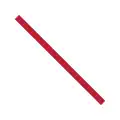 Example of the 'slash' on its own, positioned according to ISO 22727:2007.
Example of the 'slash' on its own, positioned according to ISO 22727:2007. Example of the 'cross' on its own.[lower-alpha 1]
Example of the 'cross' on its own.[lower-alpha 1] Example of a 'slash' on BP 015: 'No headwear'. Note how the red slash is centered on the entire symbol.
Example of a 'slash' on BP 015: 'No headwear'. Note how the red slash is centered on the entire symbol. Example of a 'cross' on BP 014: 'Do not smile'. Note how the red cross is specifically centered on the smile.
Example of a 'cross' on BP 014: 'Do not smile'. Note how the red cross is specifically centered on the smile.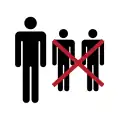 Example of a 'cross' on BP 019: 'Single person'. Note how the red cross is specifically centered on the two people in the background
Example of a 'cross' on BP 019: 'Single person'. Note how the red cross is specifically centered on the two people in the background
The slash and cross can be added to other symbols, such as a baggage cart to indicate 'no baggage carts'. ISO 7001 states that when symbols are designed, they should not have key elements that would be obstructed by the slash as positioned on the template provided in ISO 22727:2007. The slash or cross must be on top of the symbol, and should be red in color.[2]
Symbols
The standard consists of 177 symbols, divided into seven categories: accessibility, public facilities, transport facilities, behaviour of the public, commercial facilities, tourism, cultural and heritage and sporting activities.[1]
Accessibility
All symbol reference numbers in this category are prefixed with "AC", for Accessibility.
 AC 001: Full accessibility or toilets - accessible
AC 001: Full accessibility or toilets - accessible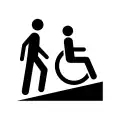 AC 002: Slope or ramped access
AC 002: Slope or ramped access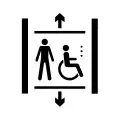 AC 003: Accessible elevator or lift
AC 003: Accessible elevator or lift AC 004: Accessibility, limited walking capability
AC 004: Accessibility, limited walking capability AC 005: Accessibility, assistance dog
AC 005: Accessibility, assistance dog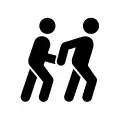 AC 006: Accessibility, personal assistant available
AC 006: Accessibility, personal assistant available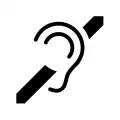 AC 007: Accessibility, hard of hearing
AC 007: Accessibility, hard of hearing AC 008: Accessibility, vision impaired
AC 008: Accessibility, vision impaired AC 009: Accessibility, blind or low vision
AC 009: Accessibility, blind or low vision AC 010: Priority access for elderly people
AC 010: Priority access for elderly people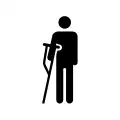 AC 011: Priority access for injured people
AC 011: Priority access for injured people AC 012: Priority access for people with internal medical conditions
AC 012: Priority access for people with internal medical conditions AC 013: Priority access for people with small children
AC 013: Priority access for people with small children AC 014 Priority access for expecting mothers
AC 014 Priority access for expecting mothers AC 015: Loop for the hearing impaired
AC 015: Loop for the hearing impaired AC 016: Priority facilities for obese people
AC 016: Priority facilities for obese people AC 017: Priority seats for elderly people
AC 017: Priority seats for elderly people AC 018: Priority seats for injured people
AC 018: Priority seats for injured people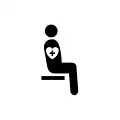 AC 019: Priority seats for people with internal medical conditions
AC 019: Priority seats for people with internal medical conditions AC 020: Priority seats for people with small children
AC 020: Priority seats for people with small children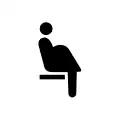 AC 021: Priority seats for expecting mothers
AC 021: Priority seats for expecting mothers AC 022: Priority seats for obese people
AC 022: Priority seats for obese people
Public facilities
All symbol reference numbers in this category are prefixed with "PF", for Public Facilities.
 PF 001: Information
PF 001: Information PF 002: Hospital
PF 002: Hospital PF 003: Toilets - unisex
PF 003: Toilets - unisex PF 004: Toilets - male
PF 004: Toilets - male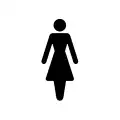 PF 005: Toilets - female
PF 005: Toilets - female PF 007: Drinking water
PF 007: Drinking water PF 008: Check-in or reception
PF 008: Check-in or reception PF 009: Lost and found or lost property
PF 009: Lost and found or lost property PF 010: Tickets or ticket sales
PF 010: Tickets or ticket sales PF 011: Ticket validation
PF 011: Ticket validation PF 012: Baggage storage or left baggage
PF 012: Baggage storage or left baggage PF 013: Baggage lockers or coin lockers
PF 013: Baggage lockers or coin lockers PF 014: Lounge or waiting area
PF 014: Lounge or waiting area PF 015: Smoking area or smoking allowed
PF 015: Smoking area or smoking allowed PF 016: Post or Post office or mail box
PF 016: Post or Post office or mail box PF 017: Telephone
PF 017: Telephone PF 018: Baggage trolleys or carts
PF 018: Baggage trolleys or carts PF 019: Elevator or lift
PF 019: Elevator or lift PF 020: Escalator
PF 020: Escalator PF 021: Stairs
PF 021: Stairs PF 023: Nursery or baby care
PF 023: Nursery or baby care PF 024: Cloakroom
PF 024: Cloakroom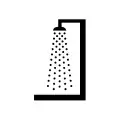 PF 025: Shower
PF 025: Shower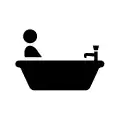 PF 026: Bath
PF 026: Bath PF 027: Trash box or Litter bin or Rubbish bin
PF 027: Trash box or Litter bin or Rubbish bin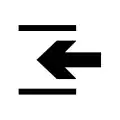 PF 028: Way in or Entrance
PF 028: Way in or Entrance PF 029: Way out or Exit
PF 029: Way out or Exit PF 030: Direction arrow
PF 030: Direction arrow PF 032: Moving walkway
PF 032: Moving walkway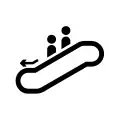 PF 033: Escalator, down
PF 033: Escalator, down PF 034: Escalator, up
PF 034: Escalator, up PF 036: Child health care centre
PF 036: Child health care centre PF 037: Library
PF 037: Library PF 043: Dentist
PF 043: Dentist PF 044: Health care centre or Doctor
PF 044: Health care centre or Doctor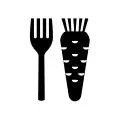 PF 050: Vegetarian food
PF 050: Vegetarian food PF 054: Museum
PF 054: Museum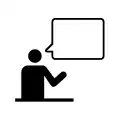 PF 062: Communication in the specified language
PF 062: Communication in the specified language PF 063: Recycling – cans
PF 063: Recycling – cans PF 064: Recycling – magnetic type of steel
PF 064: Recycling – magnetic type of steel PF 065: Recycling – glass
PF 065: Recycling – glass PF 066: Recycling
PF 066: Recycling PF 067: Pedestrian underpass
PF 067: Pedestrian underpass PF 068: Baggage delivery
PF 068: Baggage delivery PF 069: Baggage assistant
PF 069: Baggage assistant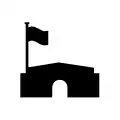 PF 070: Embassy
PF 070: Embassy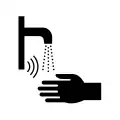 PF 074: Automatic sensor faucet or tap
PF 074: Automatic sensor faucet or tap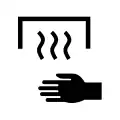 PF 075: Hand Dryer
PF 075: Hand Dryer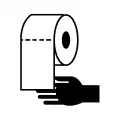 PF 076: Toilet paper
PF 076: Toilet paper PF 077: Drinking water fountain
PF 077: Drinking water fountain PF 078: Elevator for goods
PF 078: Elevator for goods PF 079: Men’s changing room
PF 079: Men’s changing room PF 080: Pedestrian overpass or footbridge
PF 080: Pedestrian overpass or footbridge PF 081: Women’s changing room
PF 081: Women’s changing room PF 082: Recycling – plastics
PF 082: Recycling – plastics
Transportation facilities
All symbol reference numbers in this category are prefixed with "TF", for Transport Facilities.
 TF 001: Airport, or Aircraft
TF 001: Airport, or Aircraft TF 002: Railway station, or Railways, or Trains
TF 002: Railway station, or Railways, or Trains TF 003: Underground, or Metro railway station, or Trains
TF 003: Underground, or Metro railway station, or Trains TF 004: Port, or Ships, or Ferries, or Boats
TF 004: Port, or Ships, or Ferries, or Boats TF 005: Heliport, or Helicopters
TF 005: Heliport, or Helicopters TF 006: Bus station, or Bus stop, or Buses
TF 006: Bus station, or Bus stop, or Buses TF 007: Tram, or Streetcar stop, or Trams, or Streetcars
TF 007: Tram, or Streetcar stop, or Trams, or Streetcars TF 008: Taxi stop, or Taxis
TF 008: Taxi stop, or Taxis TF 009: Rent-a-car, or Car rental/hire
TF 009: Rent-a-car, or Car rental/hire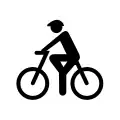 TF 010: Bicycle, or Cycle facility
TF 010: Bicycle, or Cycle facility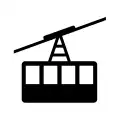 TF 011: Cable car
TF 011: Cable car TF 012: Funicular, or Cable railway
TF 012: Funicular, or Cable railway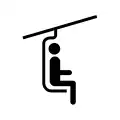 TF 013: Chair lift
TF 013: Chair lift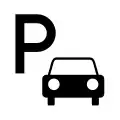 TF 014: Parking, or Car parking
TF 014: Parking, or Car parking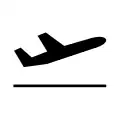 TF 015: Flight departures
TF 015: Flight departures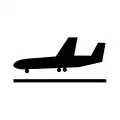 TF 016: Flight arrivals
TF 016: Flight arrivals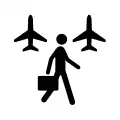 TF 017: Flight connections
TF 017: Flight connections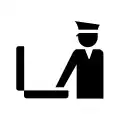 TF 018: Customs, or Baggage check
TF 018: Customs, or Baggage check TF 019: Immigration, or Passport control/inspection
TF 019: Immigration, or Passport control/inspection TF 020: Baggage reclaim
TF 020: Baggage reclaim TF 021: Bicycle or cycle parking
TF 021: Bicycle or cycle parking TF 027: Airport bus
TF 027: Airport bus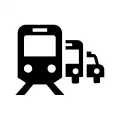 TF 028: Transportation Centre
TF 028: Transportation Centre TF 029: Rental bicycle
TF 029: Rental bicycle TF 030: Baggage weighing
TF 030: Baggage weighing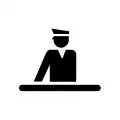 TF 031: Quarantine
TF 031: Quarantine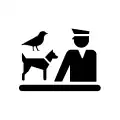 TF 032: Quarantine, animal
TF 032: Quarantine, animal TF 033: Quarantine, people
TF 033: Quarantine, people TF 034: Quarantine, plant
TF 034: Quarantine, plant TF 035: Water taxi, or Water taxis
TF 035: Water taxi, or Water taxis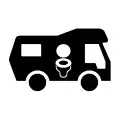 TF 036: Self-contained camper van
TF 036: Self-contained camper van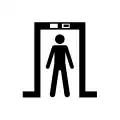 TF 037: Security check
TF 037: Security check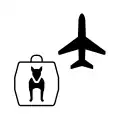 TF 038: Animal transportation
TF 038: Animal transportation TF 039: Bus disembarkation
TF 039: Bus disembarkation TF 040: Bus embarkation
TF 040: Bus embarkation TF 042: Meeting point
TF 042: Meeting point TF 043: Tour group meeting point
TF 043: Tour group meeting point TF 044: Electric vehicle charging station or point
TF 044: Electric vehicle charging station or point
Behaviour of the public
All symbol reference numbers in this category are prefixed with "BP", for Behaviour of the Public.[lower-alpha 2]
 BP 001: Quiet please or Silence
BP 001: Quiet please or Silence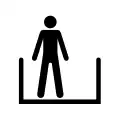 BP 002: Stand on the left (or Right)
BP 002: Stand on the left (or Right)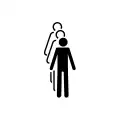 BP 003: Line up or queue in single file
BP 003: Line up or queue in single file BP 004: Line up or queue in twos
BP 004: Line up or queue in twos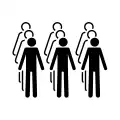 BP 005: Line up or queue in threes
BP 005: Line up or queue in threes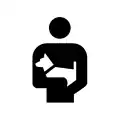 BP 006: Dogs should be carried
BP 006: Dogs should be carried BP 007: Take off your shoes
BP 007: Take off your shoes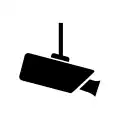 BP 008: Surveillance camera
BP 008: Surveillance camera BP 009: Biometric facial recognition facility
BP 009: Biometric facial recognition facility BP 010: Look to a point
BP 010: Look to a point BP 011: Manual passport control
BP 011: Manual passport control BP 012: Move hair
BP 012: Move hair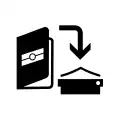 BP 013: Open passport and place on scanning device
BP 013: Open passport and place on scanning device BP 014: Do not smile
BP 014: Do not smile BP 015: No headwear
BP 015: No headwear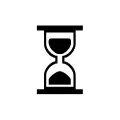 BP 016: Wait
BP 016: Wait BP 017: No sunglasses
BP 017: No sunglasses BP 018: Single person
BP 018: Single person BP 019: Proceed forward
BP 019: Proceed forward
Commercial facilities
All symbol reference numbers in this category are prefixed with "CF", for Commercial Facilities.
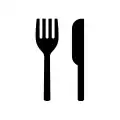 CF 001: Restaurant
CF 001: Restaurant CF 002: Refreshments, coffee shop or café or buffet
CF 002: Refreshments, coffee shop or café or buffet CF 003: Hotel or Accommodation
CF 003: Hotel or Accommodation CF 004: Money/currency exchange or Bureau-de-change
CF 004: Money/currency exchange or Bureau-de-change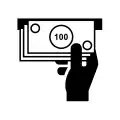 CF 005: Cash service or Cash dispenser or ATM
CF 005: Cash service or Cash dispenser or ATM CF 006: Shops or Shopping
CF 006: Shops or Shopping CF 007: Pharmacy
CF 007: Pharmacy CF 008: Bar
CF 008: Bar CF 009: Filling station
CF 009: Filling station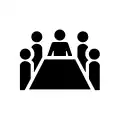 CF 010: Conference facilities or Meeting room
CF 010: Conference facilities or Meeting room CF 011: Internet café
CF 011: Internet café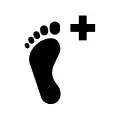 CF 012: Foot care or Podiatry
CF 012: Foot care or Podiatry CF 014: News stand or News kiosk or Newsagent
CF 014: News stand or News kiosk or Newsagent CF 015: Barber or Hair salon
CF 015: Barber or Hair salon CF 016: Cinema
CF 016: Cinema CF 017: Car repair workshop
CF 017: Car repair workshop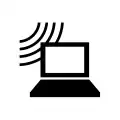 CF 018: Wireless LAN
CF 018: Wireless LAN CF 019: Shoeshine
CF 019: Shoeshine CF 020: Snack machine
CF 020: Snack machine CF 021: Dance hall or ballroom
CF 021: Dance hall or ballroom CF 022: Laundry service
CF 022: Laundry service
Tourism, culture and heritage
All symbol reference numbers in this category are prefixed with "TC", for Tourism, Culture and heritage.
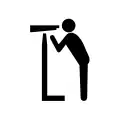 TC 001: Viewpoint or panorama
TC 001: Viewpoint or panorama TC 002: Campsite or Camping
TC 002: Campsite or Camping TC 003: Caravan park or Caravans
TC 003: Caravan park or Caravans TC 004: Picnic area
TC 004: Picnic area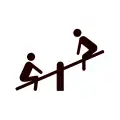 TC 005: Play area
TC 005: Play area TC 006: Park, recreational
TC 006: Park, recreational TC 007: Zoo
TC 007: Zoo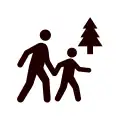 TC 008: Natural area with public access
TC 008: Natural area with public access TC 009: Hiking trail
TC 009: Hiking trail TC 010: Location for Campfires
TC 010: Location for Campfires TC 011: Bird sanctuary
TC 011: Bird sanctuary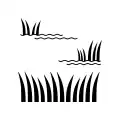 TC 012: Wetland reserve
TC 012: Wetland reserve TC 013: Hot spring or Hot tub
TC 013: Hot spring or Hot tub TC 014: Audio tour
TC 014: Audio tour TC 015: Indoor play area
TC 015: Indoor play area TC 016: Packed lunch room
TC 016: Packed lunch room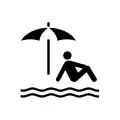 TC 017: Beach
TC 017: Beach TC 018: Planetarium
TC 018: Planetarium
Sporting activities
All symbol reference numbers in this category are prefixed with "SA", for Sports Activities.
 SA 001: Sporting activities or general sports
SA 001: Sporting activities or general sports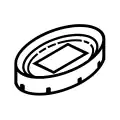 SA 002: Stadium
SA 002: Stadium SA 003: Indoor swimming pool
SA 003: Indoor swimming pool SA 004: Sports hall
SA 004: Sports hall
See also
- DOT pictograms - United States version of this standard.
- ISO 7010 - ISO Standard for safety symbols.
Notes
References
- 1 2 3 ISO 7001:2023 - Graphical symbols — Registered public information symbols.
- 1 2 3 4 5 6 International Organization for Standardization (November 2011). ISO 7001 - Graphical symbols - Public information symbols (Third ed.). International Organization for Standardization.
- ↑ "EN 17210:2021 - Accessibility and usability of the built environment". 30 November 2020. 6.6.2.
{{cite journal}}: Cite journal requires|journal=(help)
External links
 Media related to ISO 7001 icons at Wikimedia Commons
Media related to ISO 7001 icons at Wikimedia Commons- The international language of ISO graphical symbols - A 2010 document published by the ISO educate about ISO graphical symbol standards ISO 7000 (Symbols for equipment), ISO 7001 (Symbols for public information), ISO 7010 (Symbols for safety signs).